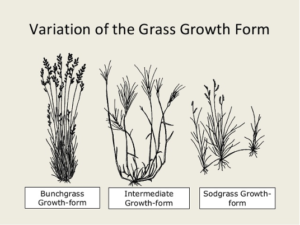Module 4: Tropical Forest Plant Growth Forms as Related to Natural Forest Management
Topic 4.6: Grasses and other Graminoids
Grasses are members of the large (12,000 species) and nearly ubiquitous family, Poaceae. Unlike woody dicotyledons, they lack a vascular cambium and thus do not have “secondary” growth (i.e., increases in stem thickness). Despite this limitation, some tropical bamboos reach 30 cm in DBH and 30 m in height. Most grasses are capable of vegetative expansion via either stolons (modified above-ground stems) or rhizomes (modified below-ground stems), but there are also many species of bunchgrasses (Figure 4.6.1).

Figure 4.6.1. Growth forms of grasses. Not shown are grasses that spread with modified underground stems called rhizomes.
Although grasses provide abundant food for humans and our livestock, they can also be pernicious silvicultural weeds. Four basic characteristics of grasses and other graminoids (=grass-like plants) contribute to their capacity to suppress forest regeneration and otherwise modify ecosystem processes:
- Potentially high rates of growth, especially among species employing the “C-4” photosynthetic pathway.
- Rapid and extensive clonal growth (=vegetative expansion) in many species through production of rhizomes or stolons.
- Long and thin leaves that dry rapidly, are highly flammable, and are concentrated near the ground.
- Basal meristems that confer resistance to fire and herbivore damage.
Among the approximately 12,000 species of grass in the world (i.e., members of the Poaceae), many of the 1000 species of bamboo are of great local, regional, and even international value. Although these giant grasses technically do not produce wood (i.e., a product of a vascular cambium, which grasses lack), the stems of many species are used as wood in construction, for flooring, and many other ways.
